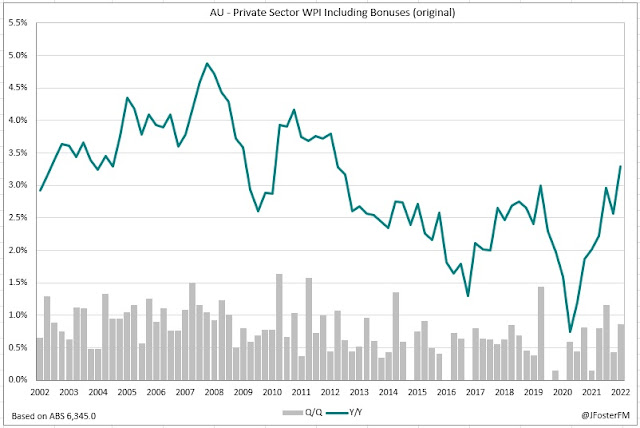Australian wages growth was softer than expected rising by 0.7% in the June quarter and 2.6% over the year. There were signs in the private sector that a tightening labour market is leading to wage pressures, consistent with the signals in survey data. In combination with the recent increase to the national minimum wage and changes to public sector wage policies, wages growth should rise towards the 3% pace expected by the RBA by the end of the year.
Wage Price Index — Q2 | By the numbers
- The headline WPI (total hourly rates of pay ex-bonuses) came in at 0.7% in the June quarter and 2.6% over the year (prior: 2.4%Y/Y), with both outcomes 0.1ppt below consensus.
- Private sector WPI lifted by 0.7%q/q, in line with the previous two quarters, as the annual pace firmed from 2.4% to 2.7%.
- Growth in the public sector WPI was 0.6% in the quarter and 2.4% over the year; these outcomes compare to 0.6%q/q and 2.2%Y/Y in the March quarter.
Wage Price Index — Q2 | The details
According to the ABS, the average size of private sector pay increases was 3.8% in the June quarter, the fastest quarterly rise seen in 10 years. The effects of a tightening labour market and CPI-linked enterprise agreements drove this increase in quarterly pay. Although only 14% of jobs were reported to have received an increase during the quarter, this was slightly higher than occured during the June quarter in 2020 (9%) and 2021 (12%).
Headline growth in the private sector WPI was 0.7% in the June quarter, which lifted the annual increase from 2.4% to 2.7%. This remains in front of wages growth in the public sector at 0.6%q/q and 2.4%Y/Y, due to wage policies implemented by state governments across the nation; though in many cases these will ease from next quarter. Public sector wages lifted sharply in Queensland (1.2%q/q, 4.0%Y/Y) due to a change in wage settings in the state.
At the industry level, the standout rise in wages growth in the June quarter was in the construction industry. Shortages of skilled labour saw wages growth rising by 1.4% in the quarter, its sharpest acceleration in 8 years, to be up by 3.4% through the year, the fastest of all industries.
Annual wages growth remains at the stronger end of the scale in business and related services. High levels of churn in these industries, with many workers switching jobs over the pandemic, has helped push up wages growth in a tightening labour market.
Wage Price Index — Q2 | Insights
Today's outcome was in line with the RBA's August forecasts for wages growth, which it anticipates to rise to 3% by the end of the year. Another strong labour market report tomorrow would likely seal another 50bps rate hike in September. A more pronounced rise in wages growth is likely to be seen next quarter as the recent decision by the Fair Work Commission to raise the national minimum wage by 5.2% starts to flow through and as new wage policies in the public sector take effect.










